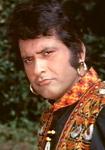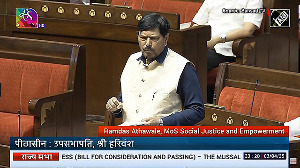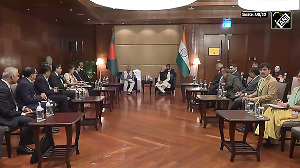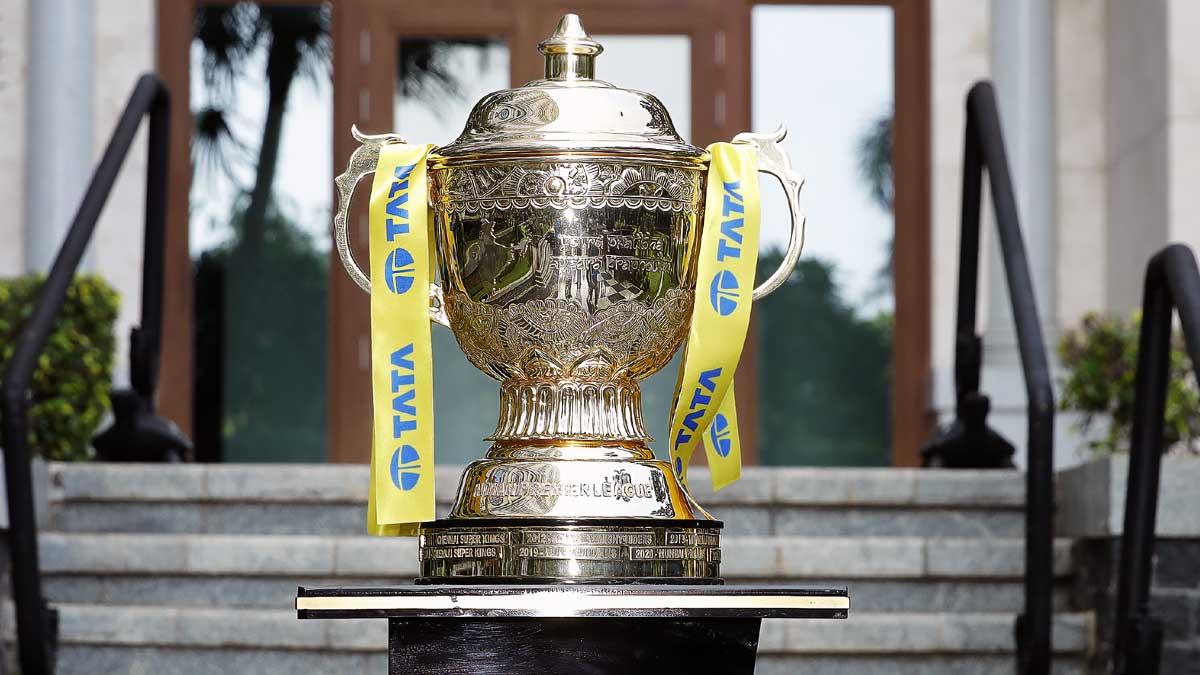Brian Lara scored a fighting century as the West Indies ground out a draw in the second Test against India on Wednesday.
The West Indies captain compiled a dogged 120 off 307 balls, his 32nd Test century, on the fifth day of the Test to deny India victory, which looked certain before rain washed out play on the fourth day.
The West Indies started the final day on 43 for one in their second innings, trailing India by 330 runs on the first, and batted through 98 overs to reach 294 for seven when stumps were drawn.
The first match in the four-Test series was drawn, the West Indies' last-wicket pair denying India victory.
Virender Sehwag, who scored 180 in India's first innings and claimed four wickets in the match, was adjudged the man of the match.
Morning session
Of all the options the West Indies had going in on the final day to save the second Test, they opted for the very worst.
From ball one, it was clear that the intent especially against the spinners was to try and take as many deliveries on the pad as possible, while keeping the bat high out of line or tucked well behind the pad.
As ploys go, it is as cynical as they come - the batsman is putting his trust not on skill, but on the umpire's cupidity and that unwritten ephemeral, the 'benefit of doubt'. The real problem with it is that when you stick your pad out that way, farther than you would if you intended to play the ball, you then that much further to bring the bat around, in the event you see a problem and decide on a defensive push.
Showing unsuspected tactical sense, Virender Sehwag exposed the ploy early on when, after Ganga had padded away four of five deliveries and was lucky to escape the decision at least once, he switched to around the wicket.
That changes the angle of attack; it takes away from the batsman the ploy of sticking his foot outside line of off, and it forces the batsman to meet it with his bat. In the event, Ganga got it on his pad again and again, was lucky.
That last appeal provides scope for a tangential sidebar. While discussing why the batsman was not give out, the commentators of the time, Dean Jones and Laxman Sivaramakrishnan, suggested that it was 'more of a polite inquiry', as opposed to a real shout.
Increasingly, it seems to me, there are two rule books - the one we are familiar with, and one written in some long dead language only a television commentator can decipher: I mean, you actually only have to turn to the umpire and ask, in your softest voice. There is nothing in the rules that says an umpire should decide on an appeal based on the volume and pitch of the acapella chorus.
Ironically, if the bowler or fielders or one of their relatives gets a bit too enthusiastic, they get fined for excessive appealing - Sehwag already has, which makes his 'polite inquiry' completely understandable.
Non sequiturs aside, Ganga's attempt to try out for the World Cup soccer tournament met the expected end: In the over immediately following Sehwag's, Anil Kumble foxed him with a beautifully disguised googly. The batsman by rote stuck his front foot a long way out, lifted his bat a long way overhead, and watched in bewilderment as the ball he expected to leave him curled back in and clipped off stump (Here's the irony: had that hit the pad instead, he would have been given not out, because he was 'a long way forward').
Amusingly, Kumble had to appeal to get the 'bowled' verdict - Ganga stood rooted for long moments, showing no inclination to leave, forcing the bowler to ask the unusual question. There was more than a hint of pique about the appeal - an indication, from the usually phlegmatic leggie, that the Indians are getting a touch tired of having to take a half dozen wickets before being given one.
The wicket fell in the 23rd over (26/66 Ganga; 51/2 West Indies). And if HawkEye, Crincfo's newly acquired property, was right, Ramnaresh Sarwan was gone - again, padding up to a full length flipper first ball.
Having got the benefit on that one, Sarwan lasted 8 more deliveries before Munaf Patel, switched on in place of Virender Sewhag, took him out with a beauty. The bowler hit the channel on a full length; Sarwan stood in place and prodded in defense; the ball did just enough off the deck to find the outer edge through to the keeper (1/10; 53/3).
Shivnariane Chanderpaul and Brian Lara then settled down to play mostly as cricket is meant to be played - with the bat. The two most experienced members of the side took to using quick pushes on either side of the wicket, into gaps created by the need to keep a close cordon, to nudge quick runs. While the runs themselves are largely irrelevant in context of the game, the fact of making them rotates strike, and keeps the bowlers from working on any one batsman.
The two put up the first 50-partnership of the innings, off 108 deliveries, in the second hour of play.
Both did take their fair share on the pads; both survived very close calls that likely would have gone the other way except for umpires who seem increasingly embarrassed to give so many LBW decisions in one game. But to their credit, they hung on.
Lara's innings was particularly noteworthy: Forced by circumstances to play like a mortal, he showed a willingness to be human, to struggle, to eschew the carefree rapture of his natural style and grind it out for over after over.
The play was all about move and counter-move: when Lara took to standing well outside his crease to the seamers to negate swing and counter the possibility of LBWs, Dhoni promptly came up to the stumps, sacrificing a possible edge to keep the batsman honest and give the bowler a better chance. Again, both batsmen took as much 'injury time' as they could get, with a hopeful eye cocked not so much on time but on clouds, the possibility of rain and such.
The first hour of play produced 40 runs in 19.3 overs for the loss of two wickets - and, this being the real key to the game, a further 80 overs remained in play.
Having noticed Lara driving at him a long way from his body and, on one occasion, inner edging very close to off, Kumble tried the line again, turning the ball in from wide of off. Lara predictably went for it, as predictably, he got the inner edge and for the second time in two overs, the ball shaved the stumps en route to fine leg fence for the four that got the Windies captain to his 50 (137 balls, three fours).
Dravid brought Sehwag back for Pathan, and the very first ball found the edge on a Chanderpaul drive, only to fall an inch short of Dravid at slip. That in fact was pretty much how it went, for the rest of the session - play and miss, play and hit, play and leave, get medical attention.
Every so often in a match you hit a point where patience is the only tool at hand, and India have hit it here - it will be interesting to see if they can keep their patience longer than the opposition holds its nerve.
At lunch, the West Indies had managed 86 runs for the loss of two wickets in 37.3 overs; a minimum of 61 remain to be bowled in the day.
Post-Lunch session
The god of cricket is a practical joker - it's a different thing that most times, his little japes leave players on one side or the other uprooting clumps of hair in frustration.
Take the case of Shivnaraine Chanderpaul who, on the day, dug deep into his experience to resist India's attempt to win. It wasn't pretty - a Chanderpaul innings rarely is. It wasn't even authoritative. There were numerous occasions of playing and missing; equally numerous ones of taking deliveries on the pad that on a different day, would have had him walking back.
All of that, though, does not matter quite as much as the one vital statistic: While compiling 54 (113 deliveries), he helped his captain keep the Indians at bay for 43.3 precious overs, in a dogged display that merits much praise.
His dismissal was one of cricket's little jokes. An increasingly frustrated Kumble, who on the day found his favorite mode of dismissal, the LBW, taken out of the equation entirely, bowled a rank full toss wide outside off.
It wasn't a flipper gone awry; it wasn't an attempt to bowl one wide and turn it in - it was, quite simply, a rank bad ball from a bowler whose concentration was waning in direct proportion to the rising frustration levels.
Chanderpaul could have let it go on to amputate the toes of first slip, which is where it was headed - instead, he went down on one knee and had an almighty swing, managing only to top edge the ball to mid on, where Irfan Pathan had time to say his prayers before clinging on to the steepler (181/4).
Even discounting the numerous LBW shouts - some dead on the money, some marginal, some inept - India did have its chances in the session. Sehwag, who appears to have reinvented himself as a bowler who can bat, in the midst of an exhibition of classical, controlled off spin made one turn sharply enough to beat even Lara's defensive bat; the edge flew to gully and Laxman took an eternity to bring himself down to ground level, by when the ball had grounded.
At the other end, Kumble hurried one onto the batsman, whose scrambled defensive push found the edge onto the pad. Yuvraj Singh at square leg, having been hit a couple of times with fierce sweeps, was just that pace too deep, just that fraction too prone to lean back, to be able to dive forward and get his palm under the ball.
With Dwayne Bravo settling into grim defense after opening out with a fine drive through the off, Lara dug in even deeper following the departure of Chanderpaul, farming strike, taking most of Sehwag's off spin and keeping the bowler, who was getting turn and some bounce, away from Bravo, whose defensive technique to spin around the off stump is not of the very best.
With the West Indies on 196/4 after 80 overs, Dravid claimed the new ball - and gave it to Sehwag; an interesting ploy to provide the spinners with a harder ball sporting a more pronounced seam. At the other end, Munaf took the ball, in the lead up to tea.
Nine years almost to the day (it was in April 1997) since he scored his only century against India ever in Tests (at St Johns, in a game reduced to an innings and a half by the elements), Brian Lara moved to a second - and potentially, far more valuable - century in Patel's first over with the second new ball, first flicking him stylishly through midwicket, then driving him one handed through the covers for a brace.
A crashing square drive off the back foot off Pathan, who took over from Sehwag after the offie had bowled just the one experimental over with the new ball, got Lara to the landmark off 272 deliveries (9 fours); the 214 dot balls they comprised were a tribute to a captain battling, almost-singlehandedly, to haul his team to safety. The century, his 32nd, brought him level with Steve Waugh, though the Aussie skipper took 168 Tests to get to a mark Lara managed in just 126.
Brief glimpses of the man at his best dispelled the gloom - and none shone brighter than a square drive off Patel almost on the stroke of tea, that was pure copybook. Lara's copybook, that is - reaching wide to get to a delivery angling across him, playing with the full flourish and smacking it with ease through the gap left vacant at point inviting him to try just that.
Bravo has hung on grimly for 51 deliveries, when tea was taken at 221/4 after 87 overs; in the final session of the match, a minimum of 29 overs remain to be bowled. Another vital stat: When the curtain comes down on this match, 351.3 overs would have been bowled - against the mandated match total of 450.
Post-Tea session
My most treasured cricket picture is of a famous field set by Ian Chappell, that had all 10 men behind the batsman's back as Dennis Lillee steamed in to bowl.
It's the most arrogant challenge you can possibly throw at a batsman - there you go, off side free, leg side free, straight field free, make all the runs you want, if you can last.
Out of the box attitudes of that kind have historically been un-Indian; no contemporary captain I've seen lead has shown the remotest flair for the out of ordinary, the unexpected, the unusual (the late Indian charge against England at Nagpur is the only time in recent history we came close).
Manish and I were exchanging emails last evening, and in course of that, this is the point that I was making: Having lost an entire day, India go in to the final day with nothing to lose; there is no conceivable way the West Indies could have won.
The occasion called for extraordinary flair: A Kumble, or a Sehwag, say, bowling with slip, gully, silly point, silly mid off, silly mid on, short square, leg slip. It leaves just two men to patrol vast acreage - but so what?
You are basically telling the batsman there is a boundary to be had every ball, if you are good enough to keep hitting them through the full space of 90 overs. And even if you can, you still cannot win. Against that, all it takes is the slightest mistake, and you are gone, history.
I was telling Manish I didn't expect Rahul Dravid to try something of the kind - just as I never expected any of his predecessors, over the past 30-odd years, to come up with the innovative, the startling, the unexpected.
And I wasn't disappointed. By conventional yardsticks, the field placement remained aggressive throughout - several slips, gully, close catchers. But the geometry was textbook - and that same textbook contains answers the opposition knows by rote.
It was, interestingly, Lara who came up with unusual ploys - most notably, his stance, a good two and a half feet outside the stumps even when Munaf Patel bowled to him at speeds topping 137k. He employed the ploy throughout the day - that, and a deliberate front foot push into the zone outside line of off, to make sure the umpire had enough `doubt' to give him the benefit of.
It was an unorthodox way to combat a pitch where the ball, rarely if ever bouncing above stump height, produced the danger of an LBW in every other ball - and most times, the unorthodox edges the conventional, as it did here.
The Indians can take some comfort in having dominated the series beginning with the third day at Antigua; also in having lost an entire day of play - but such things don't show up at first glance on scoresheets; what does, is a score line of 0-0 after two played.
None of this is to take away from what has essentially been a good performance thus far. The team that came into this series with the reputation of never being able to play abroad, and carrying the further handicap of what has been termed a `popgun' attack, has actually outplayed the opposition, on its home turf, with both bat and ball.
Both in Antigua and here, they have defied the established canon of Indian batsmen and fresh wickets, opting for first strike. And starting with the third day of the first Test, they have dominated every single session over 7 days of Test cricket.
Yet, it has been a case of thus far, no further - and time is running out. Shortly before the team left for the 2000-2001 tour of the West Indies, then coach John Wright in course of a chat pointed out that the only way India would shake the jinx of not winning a Test series abroad was by actually going out and winning one.
You need to snap the chain at some point, that is the only way to instill the belief that it can be done, he said then - and suggested that the West Indies tour was the best opportunity India had to do the deed.
That didn't work out too well; six years later, though, the situation remains the same - the tour provides the best opportunity for the team to break through that barrier. To do that, in the time remaining, will take an attitudinal shift - after the debacle of the ODI series, the team appears to have lost a bit of its confidence with the bat; team selection has more of a care to buffering the batsmen, as opposed to looking to bowl the opposition out.
Given that Powar is totally raw (plus the wicket as it showed on day one never did look like a turning track), and the fitness problems of both Sreesanth and Harbhajan (incidentally, for those banging on about the mistake in dropping Harbhajan, what part of `unfit' do you find difficult to understand?), there isn't much the tour selectors could have done here - but going into the third Test, they are in the happy position of all bowlers being fit again.
And that ideally should dictate the selection - remove the buffer, jettison the extra batsman (on current form, the player who needs to draw the short straw is fairly obvious) and go in with a two spin, three seam attack (the seamers more for the first innings, the spinners more for the second). It is the composition they tried often, in recent times, at home - it is to my mind a composition they need even more in the Caribbean, where for the second time in two Tests, you've had a pitch that actually has gotten better with time (those watching will have noticed for instance that a pitch that was kicking up debris on day three played placid, with no sign of dust-devils, throughout today - a phenomenon at least in part likely due to the heavy rain, that would have dampened it just enough to bind).
There is one other aspect the team is consistently failing in - and that is identifying the right guy for the right fielding position, and sticking with it. In course of just this one day, I noticed for instance Yuvraj Singh fielding at slip, gully, point, cover, short square leg, midwicket and once, mid off.
Sorry, but Yuvi is no slip - and Kaif is no close fielder, period. To have a Wasim Jaffar patrolling at mid on while a Kaif, mans short square leg is misuse of resources on two counts. And not trying Yuvraj with the ball, as a surprise option, qualifies as more waste - which is not to say the part timer would have run through the team, but when the orthodox doesn't work, it doesn't hurt to try the other.
To underline it, shortly after Lara's dismissal, Kumble in the 101st over got Bravo pushing one on the leg; Kaif got it on the boot at short square - and at the time, he was fully upright, his hands waist high above the ground level, which is bizarre for a close catcher. At the time, 16 overs minimum remained to be bowled - and sure enough, Kaif was removed from the position after the horse had bolted, and Yuvraj was brought back. (Incidentally, for tactical purposes, Laxman could have been `injured' today, giving India the option of using Suresh Raina in the field - an out of the box bet missed).
Brian Lara got yet another of his many lives during the session when, in the 96th over, he took Sehwag on the pads, then shook his head and smiled at the concerted appeal. At the time, the commentators verbally echoed the smile - until the replay came on, and showed it was plumb. Just another incident, in an innings where, if all merited LBWs were given, this game would have been over before tea - but that is just something for the what-if file.
For the peace of mind of the Indians, Lara went, in the very next over. Again, Sewhag angled one in on the off; Lara looked to flick and was beaten, took it on the pad, finally got the finger, grimaced, smiled and signaled he thought he had been hard done by; predictably, the sparse crowd began booing the decision. (One of these days, this sort of cynical playing to the gallery is going to provoke ugliness - and likely, one of those interesting missives from Mount Dubai).
One aspect of the decision I am tempted to protest: Ian Bishop quickly called it not out; after a long gap, Jeremy Coney found a few questions to ask. And for once - the only time, today - the production crew left the Hawkeye out of it. How, just for academic interest, about showing the full monty, folks? How about showing the path of a ball you claim will miss off stump, just so we can see what it would have really hit? At the very least, it would have stopped the booing of the crowd.
No matter - it was a masterly display of leading by example. It took tremendous confidence to walk out at number three, with a wicket falling in the first over of the follow on innings, after having failed with the bat through the first three innings; it took tremendous discipline, enormous concentration, to battle against the natural grain, to stick it out for 307 deliveries, to ensure that his team did not crumble.
In the 107th over Bravo - who, an over ago, had danced down to loft Kumble over long off for six - was pushed back by a quicker delivery that turned, jumped, flicked bat and pad for Yuvraj, up close on the leg side, to take diving headlong forward (47.122; Windies 277/6).
Munaf Patel was brought on in the closing stages - and in the midst of an over in which he bowled his heart out, the seamer brought Ramdhin forward, found his edge, and the ball went right through the hands of Rahul Dravid, diving to his left at second slip. (That's the other thing about fielding positions - if you spend half your life in one position, why move? Dravid traditionally fields at first, not second, slip - and there's a difference in how fielders react in these two positions; witness the fact that Dravid was diving in front of first slip, who had the far better chance of making the catch. A tangential query - when did Sehwag, who used to snaffle some good ones, slip out of the slip cordon?).
In the next over, Bradshaw deliberately took a Kumble delivery on his pads. To quote Ian Bishop, "Hawkeye says that was straight enough, and low enough to have hit the stumps". Ooops.
Next over - Bradshaw looks to play a full length delivery from Munaf Patel to leg; he misses, is hit on the pad. Jeff Dujon: "For my money, that was close". Ian Bishop: "He was struck inside the line of off stump and that looks a very good shout indeed." Hawkeye says it was going between middle and leg. Bishop: "Bradshaw lucky to be there, on two occasions." Ooops.
Finally, Munaf got the consolation his bowling more than deserved - Bradshaw again shuffled into his crease, the full, straight, quick ball nailed the batsman in front of the stumps, and Asad Rauf figured what the hell, might as well give one (291/7).
It was too little too late, though - the next over was the last, and the West Indies walked off the park having pulled off yet another escape Houdini would be proud of.








 © 2025
© 2025